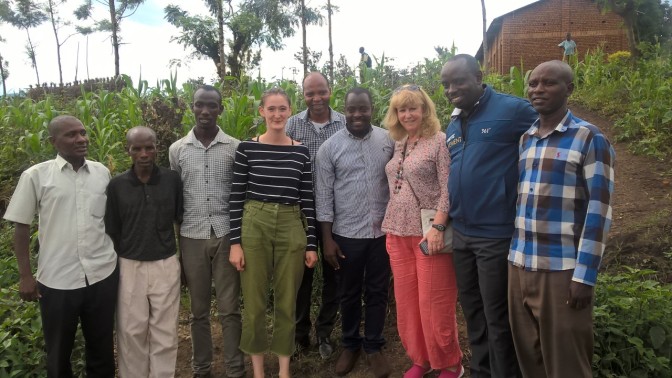During the week we had the opportunity to visit two primary schools where we are planning to expand our project programme in the future.
The first is Ryankana, situated on the outskirts of Bugarama, and in the poorest section of the town. The school has over 2,000 pupils and, like many schools in Rwanda, copes with these numbers with a double shift system – half of the pupils come to class in the mornings, the other half come in the afternoon. The government is now trying to phase out this system, starting next year with the oldest classes, P4 and P5. This is going to put enormous pressure on the available classrooms, alongside the growing population.
Ryankana currently has 24 classrooms with 70 pupils average per class. They have recently benefited from classrooms built by Kintore Rotary Club and Kemnay Academy, through RSVP, and the government is providing two new rooms – but they urgently need another nine rooms to meet the government target of 45 per class.
Our plan for next year was to renovate a number of the older classes, just as we have done in Kibangira this year, with new doors and window frames, plastering and painting the walls and new flooring – some of the rooms have just a rough, unfinished surface. This work can transform the rooms, making them much a more pleasant learning environment. However, that won’t address the most urgent situation, the need for more rooms. Given a choice between eight renovated rooms or two additional rooms, their answer was clearly for the new rooms. The old classrooms, however, dark and dingy, would still serve.
The school has a plot of land which would be ideal for a new six-room two-stores block but we are already committed to plans for a new block at Muko next Year. And Mihabura is also seeking new classrooms for an expansion into secondary provision. The scale of the challenges here is enormous. I wonder how much we can request from Jersey Overseas Aid next? They have been very generous and have been supportive of our three -year plan. We’ll have discussions with them when we get home and see where we can make the best impact with the resources available.
The second school we visited is Mubera, at a remote rural location in the hills beyond Kibangira. We drove for nearly half an hour along the ridge between the Bugarama Valley to the west and the Burundi border to the east, passing through many houses dotted throughout the hillsides. This is a very fertile area and crops are grown everywhere, even the steepest slopes. The marram road has been improved tremendously recently but as we approach Mubera it turns into a rough, narrow track.

Toni Roberts and I visited the school last year with the Mayor of Rusizi on an advance visit with Jersey Overseas Aid. This was one of the Mayor’s priority projects – it’s the poorest school in the area. It caters for 405 pupils in dark, crumbling rooms.The government has begun a rebuilding programme but half of the school remains in a desperate condition. Teacher recruitment and retention is very difficult and the pupils’ achievement record in national exams is very low and as a result no local children have the opportunity to progress to secondary schools.
Our initial reaction was that this was far too difficult a place for a traditional HATW project, given the remoteness and poor access, making it a daunting prospect for volunteers to get involved with. However, Toni has pursued this with the Rotary Club in Jersey and we have been discussing with them the possibility of a significant support programme over a number of years.
We have proposed more than just classrooms but other innovative proposals which include teachers’ accommodation, a vocational training unit, to teach employable skills such as carpentry and masonry and a school feeding programme to encourage pupil attendance and avoid school drop out. We are looking to the Mayor to improve the road access and secure water and electricity connections for the school. HATWJ role will be to monitor the project along with our local coordinator, Fulgence.
Thsi project would require a major commitment from Rotary and there is some way to go before we reach agreement with all sides. However, this exciting and ambitious project has the potential to be a beacon for educational development in the region and so we go forward ever hopeful.









